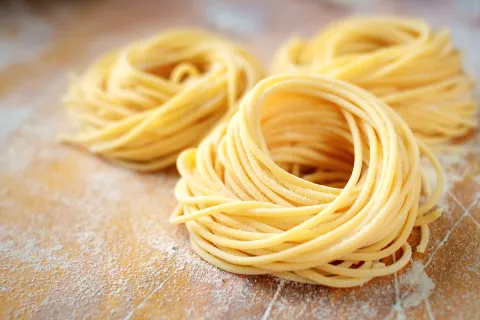Spaghetti Facts

I never gave a whole lot of thought about spaghetti when I was growing up. Mom made it about once a week. The meatless sauce, made from scratch, would be simmering on the stove most of the day, and when supper time came, the spaghetti took no time at all to cook. It was always good and included some type of bread to sop up extra sauce. I just took it for granted and never gave much thought to spaghetti. Horses, yes. Spaghetti, no.
As a young adult, I discovered, when I got out into the world, a wondrous thing called jarred spaghetti sauce. It was a super quick dinner after a long, hard workday, and my son loved it. Now, I often make my (own) sauce using a good, jarred sauce as a base. Again, not giving a whole lot of thought to spaghetti. I knew some people made pasta from scratch, but not the crowd I hung out with and certainly not me.
So, with the Lions Club Free Spaghetti Dinner coming up at 5:00 March 29th (before the Union County Opry Concert with Con Hunley), I got a little curious about spaghetti. There is, apparently, more than one definition of the word spaghetti.
According to Wikipedia, "Spaghetti code" is a derogatory term for difficult to maintain and unstructured computer source code. Can’t eat that! I don’t really understand it, either.
There are many, many forms of edible spaghetti. Spaghettini is a kind of particularly thin spaghetti. Vermicelli and angel hair pasta are thinner still. But spaghetti greatly outsells all the other pastas. Italians eat about 52 lbs of pasta a year while Americans consume around 20 lbs per year. That’s a whole lot of spaghetti!
The word "spaghetti" comes from the Italian word spaghetto, which is a diminutive of spago, meaning "thin string" or "twine". It was probably introduced to Sicily by the island’s Arab conquerors in the 8th century. The name was first recorded in 1874, however, suggesting that spaghetti may have remained a regional dish until shortly after the unification of Italy in 1861. Spaghetti was likely eaten with butter and cheese until about that time, too.
While spaghetti is reported as one of the simpler pastas to make fresh, most people go for the store-bought, dry pasta in a box. But most Italians agree that the secret to good spaghetti is cooking the pasta "al dente" (firm to the bite, not overcooked or mushy). Fun fact: al dente pasta has a lower glycemic index than pasta cooked softer! Pasta should be cooked in well-salted water, and the sauce should be finished off by adding a bit of pasta water to create a creamy coating on each noodle - essentially "cooking it in the sauce" for optimal flavor and texture. Some chefs add just a touch of sugar in the sauce to take the little “tang” that tomatoes lend.
So c'mon down to the Union County High School Commons at 5:00 on Saturday, March 29, and savor free, historic Italian spaghetti with made-from-scratch sauce, garlic bread, salad, and surprise dessert sponsored by the Union County Lions Club!
- Log in to post comments